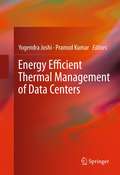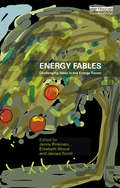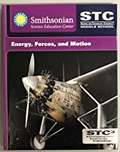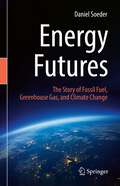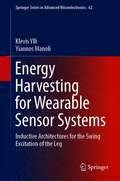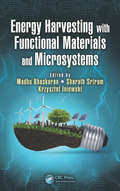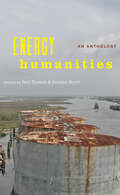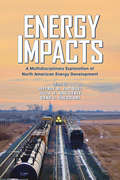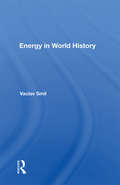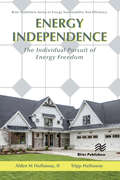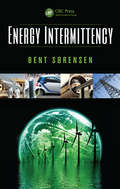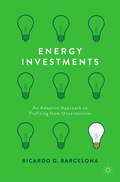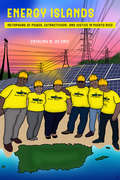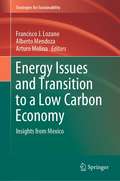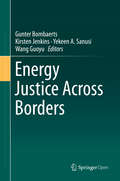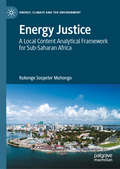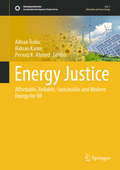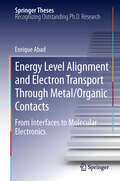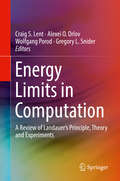- Table View
- List View
Energy Efficient Thermal Management of Data Centers
by Pramod Kumar Yogendra JoshiEnergy Efficient Thermal Management of Data Centers examines energy flow in today's data centers. Particular focus is given to the state-of-the-art thermal management and thermal design approaches now being implemented across the multiple length scales involved. The impact of future trends in information technology hardware, and emerging software paradigms such as cloud computing and virtualization, on thermal management are also addressed. The book explores computational and experimental characterization approaches for determining temperature and air flow patterns within data centers. Thermodynamic analyses using the second law to improve energy efficiency are introduced and used in proposing improvements in cooling methodologies. Reduced-order modeling and robust multi-objective design of next generation data centers are discussed.
Energy Fables: Challenging Ideas in the Energy Sector
by Jacopo Torriti Elizabeth Shove Jenny RinkinenEnergy Fables: Challenging Ideas in the Energy Sector takes a fresh look at key terms and concepts around which energy research and policy are organised. Drawing on recent research in energy and transport studies, and combining this with concepts from sociology, economics, social theory and technology studies, the chapters in this collection review and challenge different aspects of received wisdom. Brief but critical introductions to classic notions like those of ‘energy efficiency’, ‘elasticity’, ‘energy services’ and the ‘energy trilemma’, together with discussions and analyses of well-worn phrases about ‘low hanging fruit’ and ‘keeping the lights on’, articulate aspects of the energy debate that are often taken for granted. In re-working these established themes and adding twists to familiar tales, the authors develop a repertoire of new ideas about the fundamentals of energy demand and carbon reduction. This book presents a valuable and thought-provoking resource for students, researchers and policy-makers interested in energy demand, politics and policy.
Energy Footprint and Sustainability: Case Studies (Environmental Footprints and Eco-design of Products and Processes)
by Subramanian Senthilkannan MuthuThis volume orients readers to the concept of energy footprints and their implications for sustainability and offers several cases that illustrate this concept. Significantly, a detailed review chapter presents a of models and methods for measurement of energy footprints across different industrial sectors. Following this, case study chapters from India and the United States offer demonstrations of the application of the described principles. The metrics and indicators described here and means to assess them offer powerful tools for organizations to work toward sustainability and the achievement of the United nations seventeen Sustainable Development Goals.
Energy Footprints of the Bio-refinery, Hotel, and Building Sectors (Environmental Footprints And Eco-design Of Products And Processes)
by Subramanian Senthilkannan MuthuThis book deals with the energy footprints of biorefineries and the hotel and buildings sector. It presents footprint case studies, which include background information, methodological frameworks, assessment checklists, calculation tools and techniques, applications, challenges and limitations. It also discusses the application of each indicator/framework in various industrial sectors and the associated challenges, along with outlooks for the future. Consumption and conservation of energy are key elements in any industry’s sustainability strategy.
Energy Footprints of the Energy Sector (Environmental Footprints And Eco-design Of Products And Processes)
by Subramanian Senthilkannan MuthuThis book examines the energy footprints of various industrial sectors, including the bio- and hydrogen energy systems, and explores the scope for improvement, particularly in India. It focuses on the consumption and conservation of energy, which are the key elements of any industry’s sustainability strategy.
Energy Footprints of the Food and Textile Sectors (Environmental Footprints And Eco-design Of Products And Processes)
by Subramanian Senthilkannan MuthuThis book addresses energy footprints in the food and textile sectors. Each footprint case study presents essential background information and discusses the scientific consensus, methodological framework, assessment checklist, calculation tools and techniques, applications, challenges and limitations. More importantly, the book explores the application of each indicator/framework in various industrial sectors and the associated challenges, as well as outlooks for the future – essential considerations, given that energy consumption and conservation are the primary elements in any industry’s sustainability strategy.
Energy Futures: The Story of Fossil Fuel, Greenhouse Gas, and Climate Change
by Daniel SoederThe objective of this book is to help readers better understand the links between fossil fuel, greenhouse gas, and climate change in a clear, explanatory format. It avoids sensationalism and politics, using plain language to explain the details of the science, how the science works, and how we know what we know. It describes the history of fossil fuels, why fossil fuel combustion products are a problem, and what must be done to address the impacts on climate. It provides details about a number of energy engineering solutions to replace fossil fuels and technology called geoengineering that can cool the planet and directly remove greenhouse gases from the atmosphere. Some of these technologies can be implemented almost immediately, and others may be applied in the future. Many young people are pessimistic about the future and prepared to give up on addressing climate change. The book strives to maintain hope throughout that humanity can solve this and other environmental problems. The climate crisis was caused by human engineering, and human engineering can fix it. The goal is to produce informed readers that can have responsible discussions with their political leaders about implementing solutions to climate change.
Energy Harvesting for Wearable Sensor Systems: Inductive Architectures for the Swing Excitation of the Leg (Springer Series in Advanced Microelectronics #62)
by Yiannos Manoli Klevis YlliThis book investigates several non-resonant inductive harvester architectures in order to find the magnet coil arrangement that generates the largest power output. The book is useful as a step-by-step guide for readers unfamiliar with this form of energy harvesting, but who want to build their own system models to calculate the magnet motion and, from that, the power generation available for body-worn sensor systems. The detailed description of system model development will greatly facilitate experimental work with the aim of fabricating the design with the highest predicted power output. Based on the simulated optimal geometry, fabricated devices achieve an average power output of up to 43 mW during walking, an amount of power that can supply modern low-power, body-worn systems. Experiments were also carried out in industrial applications with power outputs up to 15 mW. In sum, researchers and engineers will find a step-by-step introduction to inductive harvesting and its modeling aspects for achieving optimal harvester designs in an efficient manner.
Energy Harvesting with Functional Materials and Microsystems (Devices, Circuits, and Systems #23)
by Krzysztof Iniewski Madhu Bhaskaran Sharath SriramFor decades, people have searched for ways to harvest energy from natural sources. Lately, a desire to address the issue of global warming and climate change has popularized solar or photovoltaic technology, while piezoelectric technology is being developed to power handheld devices without batteries, and thermoelectric technology is being explored to convert wasted heat, such as in automobile engine combustion, into electricity. Featuring contributions from international researchers in both academics and industry, Energy Harvesting with Functional Materials and Microsystems explains the growing field of energy harvesting from a materials and device perspective, with resulting technologies capable of enabling low-power implantable sensors or a large-scale electrical grid. In addition to the design, implementation, and components of energy-efficient electronics, the book covers current advances in energy-harvesting materials and technology, including: High-efficiency solar technologies with lower cost than existing silicon-based photovoltaics Novel piezoelectric technologies utilizing mechanical energy from vibrations and pressure The ability to harness thermal energy and temperature profiles with thermoelectric materials Whether you’re a practicing engineer, academician, graduate student, or entrepreneur looking to invest in energy-harvesting devices, this book is your complete guide to fundamental materials and applied microsystems for energy harvesting.
Energy Harvesting: Solar, Wind, and Ocean Energy Conversion Systems (Energy, Power Electronics, and Machines)
by Alireza Khaligh Omer C. OnarAlso called energy scavenging, energy harvesting captures, stores, and uses "clean" energy sources by employing interfaces, storage devices, and other units. Unlike conventional electric power generation systems, renewable energy harvesting does not use fossil fuels and the generation units can be decentralized, thereby significantly reducing transmission and distribution losses. But advanced technical methods must be developed to increase the efficiency of devices in harvesting energy from environmentally friendly, "green" resources and converting them into electrical energy. Recognizing this need, Energy Harvesting: Solar, Wind, and Ocean Energy Conversion Systems describes various energy harvesting technologies, different topologies, and many types of power electronic interfaces for stand-alone utilization or grid connection of energy harvesting applications. Along with providing all the necessary concepts and theoretical background, the authors develop simulation models throughout the text to build a practical understanding of system analysis and modeling. With a focus on solar energy, the first chapter discusses the I−V characteristics of photovoltaic (PV) systems, PV models and equivalent circuits, sun tracking systems, maximum power point tracking systems, shading effects, and power electronic interfaces for grid-connected and stand-alone PV systems. It also presents sizing criteria for applications and modern solar energy applications, including residential, vehicular, naval, and space applications. The next chapter reviews different types of wind turbines and electrical machines as well as various power electronic interfaces. After explaining the energy generation technologies, optimal operation principles, and possible utilization techniques of ocean tidal energy harvesting, the book explores near- and offshore approaches for harvesting the kinetic and potential energy of ocean waves. It also describes the required absorber, turbine, and generator types, along with the power electronic interfaces for grid connection and commercialized ocean wave energy conversion applications. The final chapter deals with closed, open, and hybrid-cycle ocean thermal energy conversion systems.
Energy Humanities: An Anthology
by Imre Szeman and Dominic BoyerHow can humanities scholars help us respond to growing concerns about climate change and fossil fuels?Energy humanities is a field of scholarship that, like medical and digital humanities before it, aims to overcome traditional boundaries between the disciplines and between academic and applied research. Responding to growing public concern about anthropogenic climate change and the unsustainability of the fuels we use to power our modern society, energy humanists highlight the essential contribution that humanistic insights and methods can make to areas of analysis once thought best left to the natural sciences.In this groundbreaking anthology, Imre Szeman and Dominic Boyer have brought together a carefully curated selection of the best and most influential work in energy humanities. Arguing that today’s energy and environmental dilemmas are fundamentally problems of ethics, habits, imagination, values, institutions, belief, and power—all traditional areas of expertise of the humanities and humanistic social sciences—the essays and other pieces featured here demonstrate the scale and complexity of the issues the world faces. Their authors offer compelling possibilities for finding our way beyond our current energy dependencies toward a sustainable future.Contributors include: Margaret Atwood, Paolo Bacigalupi, Lesley Battler, Ursula Biemann, Dominic Boyer, Italo Calvino, Warren Cariou, Dipesh Chakrabarty, Una Chaudhuri, Claire Colebrook, Stephen Collis, Erik M. Conway, Amy De’Ath, Adam Dickinson, Fritz Ertl, Pope Francis, Amitav Ghosh, Gökçe Günel, Gabrielle Hecht, Cymene Howe, Dale Jamieson, Julia Kasdorf, Oliver Kellhammer, Stephanie LeMenager, Barry Lord, Graeme Macdonald, Joseph Masco, John McGrath, Martin McQuillan, Timothy Mitchell, Timothy Morton, Jean-François Mouhot, Abdul Rahman Munif, Judy Natal, Reza Negarestani, Pablo Neruda, David Nye, Naomi Oreskes, Andrew Pendakis, Karen Pinkus, Ken Saro-Wiwa, Hermann Scheer, Roy Scranton, Allan Stoekl, Imre Szeman, Laura Watts, Michael Watts, Jennifer Wenzel, Sheena Wilson, Patricia Yaeger, and Marina Zurkow
Energy Impacts: A Multidisciplinary Exploration of North American Energy Development
by Jeffrey B. Jacquet Julia H. Haggerty Gene L. TheodoriDevelopment of various energy sources continues across North America and around the world, raising questions about social and economic consequences for the places and communities where these activities occur. Energy Impacts brings together important new research on site-level social, economic, and behavioral impacts from large-scale energy development. Featuring conceptual and empirical multidisciplinary research from leading social scientists, the volume collects a broad range of perspectives to understand North America’s current energy uses and future energy needs. Twelve chapters from respected scholars in a variety of disciplines present new ways to consider and analyze energy impact research. Focused on varied energy topics, geographies, and disciplines, each chapter includes a policy brief that summarizes the work and provides “key takeaways” to apply the findings to policy and public discourse. Meaningful public engagement is critical in limiting the negative implications of energy development, and understanding the social influences on and of energy systems is a cornerstone of addressing the climate crisis. As such, Energy Impacts is a significant work for students, scholars, and professionals working in sociology, education, geography, environmental studies, and public health. This material is based upon work supported by the National Science Foundation under Grant No. 1528422. Publication is also supported, in part, by Montana State University. Contributors: Ali Adil, Lisa Bailey-Davis, Nancy Bowen-Elizey, Morey Burnham, Weston Eaton, Heather Feldhaus, Felix Fernando, Emily Grubert, C. Clare Hinrichs, John Hintz, Richard Hirsh, Season Hoard, Tamara Laninga, Eric Larson, Achla Marathe, Natalie Martinkus, Seven Mattes, Ronald Meyers, Patrick Miller, Ethan Minier, Myra Moss, Jacob Mowery, Thomas Murphy, Sevda Ozturk Sari, John Parkins, Christopher Podeschi, Nathan Ratledge, Sanne Rijkhoff, Kelli Roemer, Todd Schenk, Anju Seth, Kate Sherren, Jisoo Sim, Marc Stern, Jessica Ulrich-Schad, Cameron Whitley, Laura Zachary
Energy In World History
by Vaclav SmilEvery human activity entails the conversion of energy. Changes in the fundamental sources of energy, and in the use of energy sources, are a basic dimension of the evolution of society. Our appreciation of the significance of these processes is essential to a fuller understanding of world history. Vaclav Smil offers a comprehensive look at the role
Energy Independence: The Individual Pursuit of Energy Freedom (River Publishers Series in Energy Sustainability and Efficiency)
by Alden M Hathaway, II Tripp HathawayThe 20th century is known to the entire world as a century of American greatness. Innovations in energy drove that American superiority; innovations such as oil pipelines, petroleum-based fuel, the light bulb, electricity, and the power grid. However, our legacy energy economy leaves us wanting in the 21st century. Centralized vulnerability, wasted generation capacity, dependence on foreign fuel, and climate change are financed by every one of us at the pump and in our monthly utility bill. However, "Energy Independence" is not about what is wrong with our current energy economy; rather it describes a bright future that is waiting to be unlocked. It presents a plan where the average homeowner can not only achieve energy freedom for their household, but usher in the new energy economy.
Energy Intermittency
by Bent SorensenThe first book to consider intermittency as a key point of an energy system, Energy Intermittency describes different levels of variability for traditional and renewable energy sources, presenting detailed solutions for handling energy intermittency through trade, collaboration, demand management, and active energy storage. Addressing energy supply intermittency systematically, this practical text: Analyzes typical time-distributions and intervals between episodes of demand-supply mismatch and explores their dependence on system layouts and energy source characteristics Simulates scenarios regarding resource time-flow, energy conversion devices, and demand structure to assist in evaluating the technical viability of the proposed solutions Discusses the conditions for establishing such systems in terms of economic requirements and regulatory measures In one concise and convenient volume, Energy Intermittency provides a comprehensive overview of all the causes and remedies of energy supply intermittency.
Energy Investments: An Adaptive Approach to Profiting from Uncertainties
by Ricardo G. BarcelonaThis book examines what lies behind the uncertainties surrounding the fuel and power markets. Exploring the role of renewables and how they potentially disrupt or create opportunities, it challenges widely accepted wisdoms in investment. The author asks questions such as: Are “business as usual” strategies that favour fossil fuels the best route to future prosperity? What prospects do firms face when their competitors diversify into renewables? Why do generous subsidies to renewables often fail to achieve wide-scale deployment? Illustrating how real options and option games reasoning yield vastly different insights from those gained from NPVs, Energy Investments offers case studies and simulations to demonstrate how firms can benefit from the methods it showcases.
Energy Islands: Metaphors of Power, Extractivism, and Justice in Puerto Rico (Environmental Communication, Power, and Culture #1)
by Catalina M de OnísEnergy Islands provides an urgent and nuanced portrait of collective action that resists racial capitalism, colonialism, and climate disruption. Weaving together historical and ethnographic research, this story challenges the master narratives of Puerto Rico as a tourist destination and site of "natural" disasters to demonstrate how fossil fuel economies are inextricably entwined with colonial practices and how local community groups in Puerto Rico have struggled against energy coloniality to mobilize and transform power from the ground up.Catalina M. de Onís documents how these groups work to decenter continental contexts and deconstruct damaging hierarchies that devalue and exploit rural coastal communities. She highlights and collaborates with individuals who refuse the cruel logics of empire by imagining and implementing energy justice and other interconnected radical power transformations. Diving deeply into energy, islands, and power, this book engages various metaphors for alternative world-making.
Energy Issues and Transition to a Low Carbon Economy: Insights from Mexico (Strategies for Sustainability)
by Arturo Molina Francisco J. Lozano Alberto MendozaWithout energy, there is no well-functioning economy, besides facing social risks. This book provides a systemic approach to energy in Mexico and its relations to the USA arising from the energy reform of the former. It covers the transition from fossil fuels to a low-carbon economy, relying heavily on renewable sources and mitigating climate change risks. Several human knowledge disciplines and topics are covered in the book, including public policy, economics, transboundary issues, electricity and thermal energy, residual biomass use, distributed energy systems and its management, and decision-making tools. An analysis is considered regarding energy issues interaction in the Mexican-USA border, which differ in both countries from pricing and policy, and the work and research that has been developed for transboundary energy trade.
Energy Justice Across Borders
by Gunter Bombaerts Kirsten Jenkins Yekeen A. Sanusi Wang GuoyuThis book is open access under a CC BY 4.0 license.We must find new and innovative ways of conceptualizing transboundary energy issues, of embedding concerns of ethics or justice into energy policy, and of operationalizing response to them. This book stems from the emergent gap; the need for comparative approaches to energy justice, and for those that consider ethical traditions that go beyond the classical Western approach. This edited volume unites the fields of energy justice and comparative philosophy to provide an overarching global perspective and approach to applying energy ethics. We contribute to this purpose in four sections: setting the scene, practice, applying theory to practice, and theoretical approaches. Through the chapters featured in the volume, we position the book as one that contributes to energy justice scholarship across borders of nations, borders of ways of thinking and borders of disciplines. The outcome will be of interest to undergraduate and graduate students studying energy justice, ethics and environment, as well as energy scholars, policy makers, and energy analysts.
Energy Justice in Latin America: Reflections, Lessons and Critiques (Routledge Explorations in Energy Studies)
by Adolfo Mejía-MonteroThis book presents valuable insights, critiques and contributions from energy researchers focused on Latin American case studies. Their work not only enriches the understanding of energy justice but also addresses a significant gap in the current academic literature.Since it was coined as an academic term more than ten years ago, energy justice has experienced accelerated growth as a relevant and widely recognised concept that allows energy researchers to engage with diverse energy issues. Nevertheless, energy justice still faces theoretical and empirical gaps, including a lack of diversity in author demographics and case studies coming from regions in the Global South. Against this backdrop, this book brings together 30 authors whose research draws from Latin American countries like Argentina, Brazil, Bolivia, Chile, Costa Rica, Ecuador, Mexico, Panama and Peru, as well as wider regional perspectives. The selected case studies combine low‑carbon transitions, regulations and technologies with issues of gender, indigeneity, (neo)colonialism, autonomy, poverty and inequality. Importantly, the chapters examine how energy justice might influence existing approaches and worldviews on sustainability, which strive for just and clean future energy systems by redressing regional inequalities and tackling the global challenge of climate change. As such, Energy Justice in Latin America opens new spaces for a growing research community to redefine and jointly construct a more complete, regionally specific notion of energy justice.Highlighting the ways in which the discussion included in this book resonates with other regions in the Global South, this volume will be of great interest to students and scholars of energy justice, energy poverty, energy democracy and energy policy, as well as Latin American studies more broadly.
Energy Justice: A Local Content Analytical Framework for Sub-Saharan Africa (Energy, Climate and the Environment)
by Rukonge Sospeter MuhongoThis book explores local content policies and their role in natural resource management within the realm of energy justice. Based on several country case studies it discusses the role of regional integration for such policies in Sub-Saharan Africa. Energy justice has been widely applied across different aspects of development, but here the principles of justice are specifically integrated with the management and implementation of oil and gas projects. Such an analysis offers novel means of implementing policies in local regions, moving away from a one-size fits all approach that leads to the ineffective transplantation of policies from developed economies to developing Sub-Saharan economies. The book argues that with a regional approach, Sub-Saharan Africa can leverage natural resources, industrial parks, supplier clusters, regional financing mechanisms and regional training facilities which would drive down the costs of production, increase efficiency and integrate the local Sub-Saharan population into the oil and gas industry. This would result in the benefits as well as the environmental concerns and responsibilities intrinsic to these industries, being spread more equally amongst local and none local stakeholders. This book will be a valuable resource for scholars and students as well as policy makers and practitioners in the areas of extractive industry-related disciplines energy governance, and economic development in Africa.
Energy Justice: Affordable, Reliable, Sustainable and Modern Energy for All (Sustainable Development Goals Series)
by Adnan Trakic Pervaiz K. Ahmed Ridoan KarimThis book delves into the pressing issue of energy justice as it relates to SDG 7 and its far-reaching implications for society. With a comprehensive exploration of various aspects, from reducing energy burdens to political considerations, environmental justice, and human rights, this thought-provoking collection of chapters offers a profound understanding of the challenges and potential solutions surrounding energy justice. Starting with an introduction to the concept of energy justice and its significance, the editors lay the groundwork for an engaging discourse. The book then delves into the disproportionate energy burdens faced by low-income communities, shedding light on the difficult choices they must make to meet their basic needs. It further examines the intricate interplay between energy justice, politics, and environmental concerns, striving to find a harmonious balance. Drawing from a diverse range of perspectives, the chapters explore the intersection of energy justice with human rights, analyzing its implications for countries worldwide. The book also investigates the influence of disruptive events on renewable energy programs, presents an Islamic perspective on energy justice, and highlights the roles of the financial sector, fossil fuel industry, nuclear energy sector, and energy technology innovation in mitigating energy injustice. Chapter 'The Role of the Financial Sector in Energy Justice' is available open access under a Creative Commons Attribution 4.0 International License via link.springer.com.
Energy Level Alignment and Electron Transport Through Metal/Organic Contacts
by Enrique AbadIn recent years, ever more electronic devices have started to exploit the advantages of organic semiconductors. The work reported in this thesis focuses on analyzing theoretically the energy level alignment of different metal/organic interfaces, necessary to tailor devices with good performance. Traditional methods based on density functional theory (DFT), are not appropriate for analyzing them because they underestimate the organic energy gap and fail to correctly describe the van der Waals forces. Since the size of these systems prohibits the use of more accurate methods, corrections to those DFT drawbacks are desirable. In this work a combination of a standard DFT calculation with the inclusion of the charging energy (U) of the molecule, calculated from first principles, is presented. Regarding the dispersion forces, incorrect long range interaction is substituted by a van der Waals potential. With these corrections, the C60, benzene, pentacene, TTF and TCNQ/Au(111) interfaces are analyzed, both for single molecules and for a monolayer. The results validate the induced density of interface states model.
Energy Limits in Computation: A Review of Landauer’s Principle, Theory and Experiments
by Wolfgang Porod Craig S. Lent Alexei O. Orlov Gregory L. SniderThis book is a single-source reference to the issues involved in the Landauer principle, which has gained new prominence recently, due to the large amount of heat generated by today’s computers. If Landauer’s principle is correct, there may be ways to build computers that dissipate far less power (corresponding to heat generated) than today’s computers. This book brings together all sides of the discussions regarding Landauer’s principle, both theoretical and experimental, empowering readers to gain better understanding of dissipation in computation, and the limits if any to progress in computation related to energy dissipation. It represents the best and most thorough examination of the important issue of Landauer’s principle that is available in one volume.Provides an in-depth investigation of the Landauer principle and how it relates to the possible existence of lower bounds on dissipation in computation;Gathers together both sides of the discussion: those who agree with Landauer and his conclusions, and those who think that Landauer was not correct, offering fresh perspective on the issues in the new light of experiments;Offers insight into the future of silicon CMOS and the limits if any to progress in computation related to energy dissipation.
